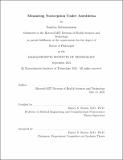Measuring Nociception Under Anesthesia
Author(s)
Subramanian, Sandya
DownloadThesis PDF (500.2Mb)
Advisor
Brown, Emery N.
Terms of use
Metadata
Show full item recordAbstract
Sixty thousand patients receive general anesthesia each day in the US alone. The problem of monitoring and managing nociception, the flow of information associated with harmful stimuli through the nervous system even when unconscious, in real time is critical during surgery. While there are measures to assess unconsciousness, immobility, and physiologic stability, objectively monitoring a patient’s nociceptive state remains challenging. Intraoperative management of nociception affects post-operative pain management and side effects such as delirium and post-operative cognitive dysfunction.
This thesis focuses on monitoring nociceptive state by tracking autonomic nervous system (ANS) responses. The two autonomic markers are heart rate variability (HRV), the beat-to-beat variation in heart rate, and electrodermal activity (EDA), the measurable change in skin conductance due to sweat gland activity. Since traditional experimental models of pain such as thermal or electrical stimulation are not adequate representations of true surgical nociception, I collected continuous electrocardiogram (ECG), EDA, and ANI data during 70 surgeries at Massachusetts General Hospital (MGH) in an IRB-approved study. I annotated the occurrence of nociceptive stimuli and retrieved the times and doses of anesthetics from the electronic medical record. First, I developed a statistically rigorous framework to extract the valuable instantaneous information from EDA. I also developed a pipeline to preprocess and clean the operating room data. Then I used two frameworks, supervised classification models and state space models, to show that my physiological indices can track the occurrence of nociceptive stimulation to determine the degree of antinociception more accurately on a subject-by-subject basis than the ANI.
In summary, I have: 1) constructed and validated quantitative multi-dimensional measures of intraoperative nociceptive state using HRV and EDA; and 2) compared these measures to the existing Analgesic Nociception Index (ANI) index for nociception monitoring using data collected during surgery. This work presents the first step towards truly integrated and physiology-based intraoperative management, and eventually closed-loop control of nociception under general anesthesia.
Date issued
2021-09Department
Harvard-MIT Program in Health Sciences and TechnologyPublisher
Massachusetts Institute of Technology